Built-in Appliances: Combining Thoughtful Design Innovation with Superior Energy Performance
Architects can specify built-in appliances with world-class design features that use less energy by incorporating the latest appropriate technology.
![]() Continuing Education
Continuing Education
Use the following learning objectives to focus your study while reading this month’s Continuing Education article.
Learning Objectives - After reading this article, you will be able to:
- Identify and recognize the attributes and features of superior energy performance in built-in appliances.
- Determine the applicable ENERGY STAR® criteria and standards for built-in appliances.
- Investigate and compare the differences between different types of heating systems for cooking.
- Specify and design appropriate built-in appliance installations for new construction and renovation projects.
Major appliances used in the design of single-family and multi-family residential buildings are evolving. Increasingly they are being designed to better respond to consumer trends, incorporate advanced technology, and perform better with less energy and water use. In short, they are becoming more sophisticated. Architects who are involved in specifying and incorporating such major appliances into their designs need to be similarly sophisticated in understanding the options and factors that influence both design appearance and performance.
Current Trends in Appliances
The ongoing evolution of appliances is driven by a number of factors that are clearly taking hold across the industry. The Association of Home Appliance Manufacturers (AHAM) is generally recognized as an excellent source of information about home appliances and is the leading trade association of the home appliance industry. The association's mission is to "serve the home appliance industry while delivering value to consumers through leadership, education and advocacy." Among other things, this includes determining consumer trends in buying appliances for new or remodel installations. According to a recent consumer preference survey conducted by AHAM, consumers are looking for appliances that are "time savers, are convenient to use, provide easy clean-up, are stylish, have multiple applications, promote healthy cooking and maintain a healthy environment in the home." That's a lot more than just the basics of heating things up or keeping them cold. And, they note that "mini kitchens" are being incorporated into nurseries, master suites, in-law suites, exercise rooms, family rooms and bathroom spas. This means that appliances are being incorporated into buildings outside of the traditional kitchen location with the design need for some non-traditional sizes and styles. When it comes to appearance, they find that "among the most desired products are kitchen electrics with the retro stainless steel look. Equally popular are high-end professional style models."
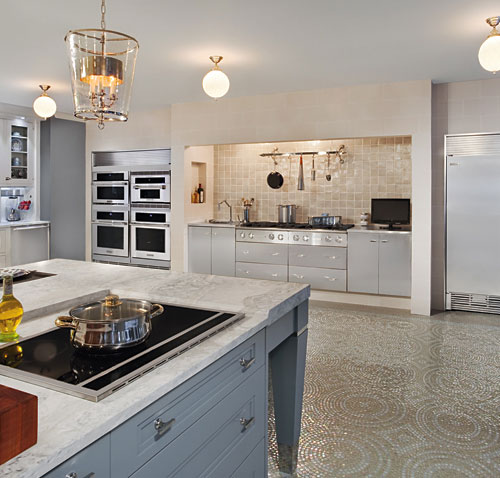 |
|
Photo courtesy of Electrolux ICON® |
Appliance manufacturers appear to be in tune with these observed trends and have invested a lot of thoughtful design into their products to address them. Probably most noticed is the incorporation of electronic control panels that allow users to plan how and when appliances will operate. Some are even touch-activated providing access to all operating functions that then fade away any choices not selected to provide clear information on what the appliance is doing. This interactive control panel concept makes sense in an environment where so many other things in our lives are controlled in a similar, electronic, manner. Further, this type of control is being applied to a variety of appliance types. Cooking appliances can be programmed for a variety of temperatures, cooking times, and sequences. Refrigeration appliances can be programmed for multiple custom or pre-set temperatures making it possible to store or serve items at their ideal temperatures. Even the lighting in appliances can be controlled to be variable in a transition manner to avoid glare yet provide ample interior light.
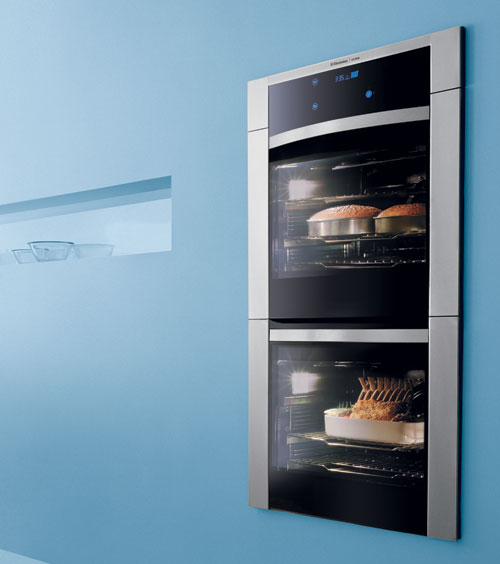 |
Glass-front oven doors are being made with enhanced materials to keep the heat in and be cool to the touch. Photo courtesy of Electrolux ICON® |
Â
When it comes to the physical features of appliances, manufacturers are keenly aware of optimizing those aspects as well. So, oven racks for example, can be designed to glide with greater ease and extend fully for effortless access to cooking food. Glass-front oven doors, notorious for being hot to the touch when the oven is in use, are being made with enhanced materials to keep the heat in and be cool to the touch instead. The additional benefits of the glass allow not only a view of what is cooking, but a hard smooth surface that is easy to keep clean.
 |
Appliances increasingly come with more sophisticated electronic control panels that respond to consumer demands and provide more options for better performance. Photo courtesy of Electrolux ICON® |
Â
Refrigeration appliances are increasingly being used for multiple functions such as automatically dispensing cold water and ice. A general concern about water quality has prompted many consumers to use water filters of some type on their drinking water faucets, but that approach can be defeated if the water comes from a refrigerator with an unfiltered line or from ice made of unfiltered water in a freezer. The response by appliance manufacturers has been to incorporate integrated water filtering systems inside of the water and ice dispensing portions of their products creating cold, clear, filtered water and ice.
With all of the above trends and developments in mind, many architects are selecting appliances that can be built-in and blend with the overall design of the space that they are a part of. This approach creates not only a more unified appearance but also a more consistent ease of use by the owners. However, the remaining important consideration of sustainability related to both longevity and energy use warrants some detailed discussion in order to address superior design and performance.
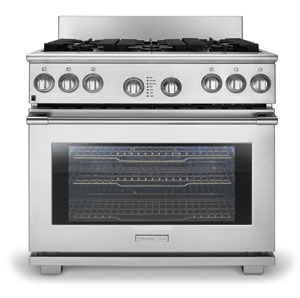 |
Due to industry-wide efforts, typically 90 percent of the steel in appliances is recycled. Photo courtesy of Electrolux ICON® |
Appliance Longevity and Recycling
According to AHAM, major home appliances have long useful lives, typically 10 to 18 years. When they do finally reach the end and are recycled, they take on new value as an important manufacturing source of raw material. In the United States, discarded appliances (also sometimes referred to as "white goods") are second only to old automobiles as a source of recycled metals, particularly steel. Using recycled steel to create new appliances has a positive impact on the environment, since it takes up to four times more energy to manufacture steel from virgin ore as it does to make the same steel from recycled material. While steel is the most abundant recyclable component in appliances, it is not the only one-they also contain other metals like aluminum and copper, as well as recyclable plastics and recoverable refrigerants.
Recognizing the significance of recycling in the appliance industry, AHAM established in 1993 the Appliance Recycling Information Center (ARIC). The mission of this center is to "serve as the authoritative source of information on the environmentally responsible disposal and recycling of appliances and to undertake research into the recycling of major household appliances." In 1994, the Major Appliance Resource Management Alliance (MARMA) was founded to expand on ARIC's mission of increasing the recycling rate of major appliances. Then in 2010, MARMA was reconstituted as the North American Appliance Resource Management Alliance (NAARMA) to allow for the inclusion of more appliance types and to broaden its reach beyond the US to now include Canada. This alliance is comprised of representatives from all sectors of the appliance industry, the steel recycling industry, the plastics council, and scrap recyclers. It serves as a forum to share ideas, discuss new technologies, advocate shared views, and promote sustainable recycling practices. Further, it develops and makes available the most accurate technical data about appliance disposal and recycling, including advances in appliance recycling technology. As a testimony to these efforts, 90 percent of the steel in major appliances is reported to be recycled.
AHAM is also a co-sponsor with the Steel Recycling Institute of the Recycling Information Center, a toll-free number that consumers and specifiers can call for information on product recycling, including the recycling of major appliances. Anyone with questions on recycling can call 1-800-YES-1-CAN (937-1226) to reach recorded messages or to ask questions of live operators.
ENERGY STAR® for Appliances
ENERGY STAR® is a well known program of the US Environmental Protection Agency (EPA) that provides a government-backed symbol for energy efficiency. It is intended to help consumers save money and protect the environment through energy-efficient products and practices. According to their website, the ENERGY STAR label was established to "reduce greenhouse gas emissions and other pollutants caused by the inefficient use of energy and make it easy for consumers to identify and purchase energy-efficient products that offer savings on energy bills without sacrificing performance, features, and comfort."
Appliances are a significant category of products within the ENERGY STAR program. Manufacturers can submit their information for review and verification by the EPA that they meet the requirements of the program in order to earn a coveted ENERGY STAR label. To qualify, appliances must minimally incorporate advanced technologies that use 10-50 percent less energy and water than standard models. In addition, all products need to demonstrate compliance with the following guiding principles as described by the EPA:
- Product categories must contribute significant energy savings nationwide.
- Qualified products must deliver the features and performance demanded by consumers, in addition to increased energy efficiency.
- If the qualified product costs more than a conventional, less-efficient counterpart, purchasers will recover their investment in increased energy efficiency through utility bill savings, within a reasonable period of time.
- Energy efficiency can be achieved through broadly available, non-proprietary technologies offered by more than one manufacturer.
- Product energy consumption and performance can be measured and verified with testing.
- Labeling would effectively differentiate products and be visible for purchasers.
This review and labeling process can serve an important role in the overall design of a green or sustainable building. Architects quite naturally often focus their efforts related to residential energy use on the building envelope and the heating and cooling systems. However, according to the ENERGY STAR program a typical home energy profile includes 29 percent on heating energy and 17 percent on cooling, or just under half of the total energy usage. The remaining 54 percent is attributed to fixtures and appliances of all types and sizes.This includes 14 percent for water heating, 12 percent for lighting, and 4 percent on electronic devices. The EPA then breaks out appliances separately to include a refrigerator, dishwasher, clothes washer and dryer as accounting for a significant 13 percent of energy use. The remaining 11 percent in their breakdown is attributed to "other" which includes stoves, ovens, microwaves, and small appliances. Combined, then, appliances can account for up to 24 percent of a typical residential energy bill. Therefore, while heating and cooling efficiency are clearly important, it is also very important to pay attention to the energy efficiency of appliances that are specified into residential units since they can also account for a significant amount of the total energy use.
The importance of energy use goes beyond the monthly utility bill, however. Most of the electricity generated in the United States still relies on the burning of fossil fuels, which dumps carbon dioxide into the atmosphere. The current calculation is that one kilowatt-hour (kWh) consumed (or saved) equals 1.43 lbs of carbon dioxide emitted (or saved) at the power plant. This is significant since carbon dioxide is one of the leading gases attributed to the "greenhouse effect" and global warming. Scientific studies have determined that the average American household consumes enough electricity to produce approximately 9,900 lbs of carbon dioxide a year-almost five tons! Specifically calling for appliances to carry the ENERGY STAR label wherever applicable is one way to improve energy efficiency in a project that can contribute to lower energy use and correspondingly lower emissions. The EPA website www.energystar.gov includes lists of manufacturers and models of all types of appliances that are rated along with recommendations for energy and water efficiency in appliances that are not rated.
Of course, the cost of appliances is also addressed in the ENERGY STAR program. Fundamentally, it should be remembered that every appliance has two price tags: a purchasing price and an operating cost. (That's not counting the environmental and health costs of burning coal and other fossil fuels in power plants.) Instead of simply comparing purchase prices with one another, the costs to operate the appliance over its useful life (10 to 18 years) should be considered. Most, but not necessarily all, appliances designed for increased efficiency carry slightly higher initial purchase costs. However, the long-term savings are significant and can create a quick payback for the small initial premium of a superior appliance. Consider that the EPA estimates that an average home spends about $2,200 on energy bills every year and the Rocky Mountain Institute (RMI) observes that "Americans spend $43 billion annually to run household appliances, which is an average of $560 per year per family. If every household in the U.S replaced old appliances with efficient models, they'd collectively save at least $15 billion per year." The U.S. Department of Energy states that, "Based on our estimates, a typical family with a home more than a decade old could save $200 per year in electricity and water bills, and 18,600 gallons of water, by switching to highly energy- and water-efficient appliances. If every American household installed these products, the annual water savings would equal the average flow of the Mississippi River into the Gulf of Mexico for five entire days." Therefore, changing to appliances that have earned the ENERGY STAR label is not so much an additional cost as it is a means to save money on energy and water costs. Hence, specifying energy-efficient appliances is good for the homeowner or renter who pays the energy bill, good for the atmosphere, and ultimately good for the environment.
With all of the above as a basis, specific types of appliances can be looked at in more detail in terms of addressing owner trends, energy and water efficiency, and specific design implications.
 |
|
Image from public domain U.S. EPA www.energystar.gov |
Â
Cooking Appliances
Very often, cooking appliances make up a significant part of a kitchen design and layout. Choices abound in size, style, finish, function, and operation and owners will have a range of desires and needs working into the final decisions of selection. Although the ENERGY STAR program does not currently apply to cooking appliances, there are nonetheless several important things to keep in mind when specifying or selecting cooking appliances.
Energy Source
There is an emerging trend to look at the best performing energy source for a specific cooking appliance, even if it is different from other appliances in the design. Many improvements in electrical cooking appliances can make them the preferred option for even heating in ovens and some types of cook-tops. Some people prefer gas-fueled cooking appliances simply because they think they offer a greater level of control than some electric ones, particularly with cook-top and range-top burners. In response to these varied preferences, manufacturers offer a variety of interchangeable and independent appliances that use either gas or electric energy as their source. Some even offer an integrated "dual fuel" option with a gas range-top and electric oven all in one appliance. The potential downside to gas cooking appliances, of course, is the indoor air quality effects of gas combustion products. Therefore, including a ventilation fan that vents directly to the outside (not recirculating) becomes a significant component of gas cooking appliances. Keep in mind however, that selecting a conventional updraft hood or a downdraft hood can make a difference in the amount of make-up air that has to be heated or cooled to offset the exhausted air; downdraft hoods generally require several times more air than conventional updraft hoods.
Example 1:Light cooking, 7 days a week, 1 time per day at 30 minutes per use Medium power setting |
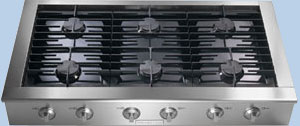 |
||||||||||||||||
Example 2:Moderate cooking, 7 days a week, 2 times per day at 30 minutes per use Medium power setting |
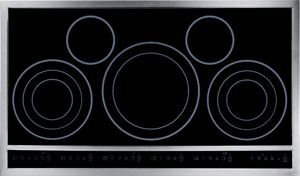 |
||||||||||||||||
Example 3:Heavy-duty cooking, 7 days a week, 2 times per day at 60 minutes per use High power setting |
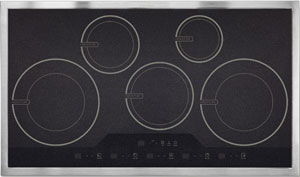 |
||||||||||||||||
Comparison of induction cooking with conventional electric radiant and gas cooking Images courtesy of Electrolux ICON® |
|||||||||||||||||
Induction Cook-tops and Range-tops
When considering electric cook-tops and range-tops, consider the following:
- Induction elements are the newest and most innovative types of cook-tops. The induction elements transfer electromagnetic energy directly to the pan, where heat is needed. When the pan is removed, there is almost no lingering heat on the cook-top. As a result, they are very energy efficient, using significantly less energy than other standard cooking elements. In fact, in a separate comparison of different types of cooking systems and design strategies, induction cooking was found to be 20 percent more efficient than typical radiant electric, and 70 percent more efficient than gas. This analysis looked at light-, medium-, and heavy-duty cooking usage and found essentially the same advantage of induction elements in all three cases.
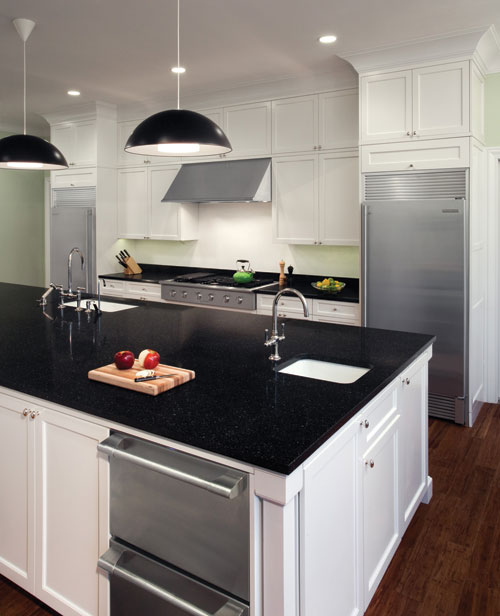 |
The U.S. EPA ENERGY STAR® program has identified typical energy uses in households. Photo courtesy of Electrolux ICON® |
Â
Cooking with induction is also more responsive than gas or electric - heat levels can be instantly adjusted from a delicate simmer or up to a quick boil. Some manufacturers have even designed in specific controls to enhance the speed of heat level changes and a variety of induction element sizes for adaptability and flexibility in cooking areas. Further, some manufacturers offer different preset touch settings on the control panel that can provide a range of preset heat levels for quick adjustments.
- Radiant electric coils by comparison, are probably the most commonly thought of electric cook-top surface, but they are known for low ratings on appearance, functionality, and energy efficiency.
- Solid disk elements are more attractive than coils and they are easier to clean. But since they heat up even more slowly than electric coils, and higher-wattage elements are generally used, energy consumption will be higher.
- Radiant elements under ceramic glass are easy to clean and heat up faster than solid disk elements, though not as quickly as conventional coil elements. The energy efficiency of ceramic glass cook-tops is higher than coil or disk element cook-tops. As with solid disk elements, flat pans are important for maximizing heat transfer from the cook-top to the pan.
- Halogen elements use halogen lamps as the heat source under a glass surface. The lamp delivers instant heat and responds very quickly to temperature setting changes. The heating efficiency of halogen units may not be better than that of ceramic glass units, and halogen elements will provide only marginally faster speed.
Ovens
When specifying ovens, there are many alternatives in terms of type of cooking method, size, energy source, and even combination of types within a single appliance. Consider the following points:
- Conventional Ovens. With standard gas or electric ovens, self-cleaning models are more energy efficient because they have more insulation. Using the self-cleaning feature more than about once a month, however, will use more energy than is saved from the extra insulation.
- Convection Ovens. These ovens can be more energy efficient than standard ovens because the heated air is continuously circulated around the food being cooked. Heat is distributed more evenly, and cooking time can be decreased. On average, convection ovens can reduce energy use by 20 percent, compared to conventional ovens.
- Microwave Ovens. Microwaves generally use one-half to two-thirds as much electricity as a conventional electric range or oven, particularly when used for reheating small portions. Because less heat is generated in the kitchen, residual savings may accrue from reduced air conditioning during the summer months.
- Warming Drawers. Smaller warming drawers installed separately from ovens can be an efficient alternative to holding food at a slightly elevated temperature without the need to use an oven. Offering flexibility and control, they also use only the amount of energy needed for warming rather than full cooking.
Since the ENERGY STAR program currently does not rate cooking appliances, specifications should not reference it as a standard for stoves, cook-tops, or ovens. Nonetheless, there are many other resources available, including those listed at the end of this article, so architects can readily find information to specify energy-efficient and environmentally responsible appliances of all types.
Refrigeration Appliances
Refrigerators and freezers are often the largest single energy-using appliance in a typical household and, consequently, are the single appliance most responsible for carbon-dioxide emissions. A typical energy bill can reflect almost as much energy use for a refrigerator (6 percent) as lighting the entire house (7 percent)-easy to understand when we realize that refrigerators necessarily need to be "on" 24 hours a day. A new, more efficient refrigerator can typically save $70 to $80 per year, and will pay for itself in about nine years. Specifying a model that qualifies for the EPA's ENERGY STAR label will be at least 15 percent more efficient than the federal minimum standard for all other refrigerators.
 |
Built-in refrigeration can enhance the overall design and functionality of kitchens and other spaces. Photo courtesy of Electrolux ICON® |
Â
When specifying energy-efficient refrigerators, consider the following recommendations:
- Specify an ENERGY STAR rated or better, refrigerator or freezer. Note that there are some models that just meet the minimum requirements, and some that far exceed them. Therefore, it is possible to specify more than just minimum (i.e., 15 percent above federal standards) requirements and accept only models that exceed requirements (i.e., 20 percent or greater than federal standards).
- Combination refrigerator/freezer appliances with either a freezer on top or, even better, in a bottom drawer, are generally more efficient than side-by-side swinging-door models, although specific data should be looked at for particular models for proper comparison.
- Manual defrost models use half the energy of automatic defrost models, but must be defrosted periodically to remain energy-efficient.
- Automatic icemakers and through-the-door dispensers will increase energy use by 14 to 20 percent.
- The most energy-efficient models are typically the 16 to 20 cubic foot sizes.
- Locate the refrigerator in a cool place away from a heat source such as an oven, a dishwasher, or direct sunlight from a window. Further, be sure to design in space that allows air circulation behind the unit.
Often the question arises regarding the number and size of refrigeration units to include in a kitchen or other locations. Generally, it is usually less costly to run one larger refrigerator rather than two smaller ones. However, for design situations that call for multiple or separated locations, each unit should be sized for optimal performance by choosing sizes and types that are best suited to the intended use and capacity. General-use refrigerators should be kept between 35 to 38 degrees Fahrenheit for best efficiency. Wine coolers which have become more popular, particularly in under-counter styles, are often kept in the 50 to 60 degree range, requiring less energy to achieve this level of cooling. Separate, smaller, under-counter ice makers may also be logical in situations where they are needed only occasionally and can be turned off in between use. This leaves room and greater efficiency in the main refrigerator or freezer for other uses.
Water-Using Appliances
In addition to energy, the importance of water conservation in appliances should not be overlooked since many recent standards with an emphasis on energy also include requirements to reduce water use. This is because it often requires a lot of energy to treat, process, and move water, not to mention the strain on the quality and quantity of local water sources. The Associated Press has reported that by 2030, the implementation of the water-saving provisions of recent environmental legislation will reduce water consumption by 10.5 trillion gallons, with a corresponding $15.3 billion saved in electricity costs. According to other news sources, "In some regions, like the western U.S., where fresh water can be scarce, household consumption has a significant impact on the watershed, which affects salmon runs and the poorer developed areas when water is diverted to supply new communities, resort areas and agriculture." Responsible use of water is a serious and growing issue that can be addressed not only in plumbing fixtures but also in electrical appliances that require water to operate, such as clothes washers and dishwashers.
Dishwashers
 |
Built-in dishwashers with appropriate controls save both energy and water. Photo courtesy of Electrolux ICON® |
Overall energy use and hot water use are the drivers in dishwasher performance. A significant portion of the energy used by dishwashers is actually the energy required for heating the water they consume, since almost all dishwashers on the market use internal booster heaters. That is actually a good thing, because it allows domestic hot water heater temperatures to be turned down to around 120 degrees, instead of the higher temperatures usually desired for dish washing. The lower water heater temperatures mean less energy is used on an ongoing basis with the higher temperature created only for the intermittent needs of the dishwasher. Specifying a dishwasher that addresses the following will help boost performance:
- ENERGY STAR rating. First and foremost, specify a model that meets or exceeds the ENERGY STAR rating requirement for both energy and water usage.
- Water usage. Specify a unit that requires less water overall and more options on controlling the water used. Many newer models have been documented to actually use half the water that conventional hand-washing would require. Further, rinsing dishes can use up to 20 gallons of water before the dishes are even loaded. ENERGY STAR qualified dishwashers used with appropriate detergents are designed to do the cleaning instead of hands.
- Rinse option. For times when dirty dishes sit overnight, a dishwasher with a rinse feature will typically use a fraction of the water needed to hand rinse.
- Load size. Dishwashers use about the same amount of energy and water regardless of the number of dishes inside, so sizing the unit to promote running full loads whenever possible will be appropriate.
- Drying. Specify units that have a no-heat drying option. This typically gives good drying results with less energy.
An additional significant specification detail is to call for a dishwasher that incorporates soil-sensors, since they adjust water use depending on how dirty the dishes are in each load. Recent improvements in test procedures better estimate the energy consumption of soil-sensing dishwasher models, allowing more accurate comparisons between models.
Clothes Washers
Hot water heating accounts for about 90 percent of the energy consumed by a clothes washer − only about 10 percent goes to the electricity to run the washer motor. Hence, specifications for washers should clearly address both energy and hot water usage. Further, most sources agree that consideration should be given to horizontal axis (H-axis) front loading washing machines. According to the Rocky Mountain Institute, "These use about half to a third of the energy of conventional vertical-axis top-loaders because they need less water to get the same load just as clean. They also have a faster spin speed than vertical axis machines, meaning that clothes will require less drying energy as a result. The energy, water, and detergent saved will cut annual washing costs by about $65, and pay back the higher up-front cost in three to nine years."
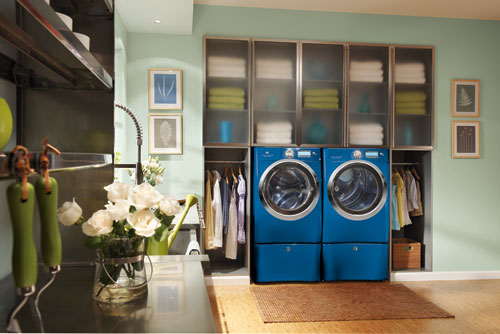 |
Front-load washers can reduce energy, water and detergent with a savings of $65 per year. Front-load dryers can save about 10 percent with temperature-sensing controls. Photo courtesy of Electrolux ICON® |
Â
Additional considerations for specification features and options that affect the amount of hot water used and the overall efficiency of a clothes washer include:
- ENERGY STAR rating. First and foremost, specify a model that meets or exceeds the ENERGY STAR rating requirement for both energy and water usage.
- Wash and rinse cycles. Select a model with many choices. Warm wash cycles clean very well. Only oily stains may require hot washes. Depending on the clothes and local water quality (hardness), many homeowners can effectively do laundry exclusively with cold water, using cold water laundry detergents. Switching to cold water can save the average household more than $40 annually with an electric water heater and more than $30 annually with a gas water heater.
- Water level controls. Generally, washing a full load is most efficient and is capable of saving more than 3,400 gallons of water each year. Nonetheless, controls should allow the option of using a smaller amount of water for small loads when needed.
- Water extraction. Higher spin speeds in washing machines will reduce drying times.
Other Appliances
Beyond the appliances already discussed, there are other general appliances that fit into designs and need some attention.
Clothes Dryers
The fundamental specification choice in clothes dryers is to select between electric and gas-fired models. In terms of comparative energy use, gas dryers are generally less expensive to operate. Most sources agree, however, that there is not a lot of variation in overall energy use between models for identical loads run for identical times. The main variables for determining the amount of energy used in dryers become the frequency of usage and the running time selected when they are used.
Beyond fuel type, controls for turning off dryers become the major specification consideration for energy consumption. The first choice is whether or not the dryer uses sensors to automatically turn off the dryer once clothes are dry. The alternative is timed drying, leaving the running time, and corresponding energy use, to the guesswork of the user. The best dryers have moisture sensors inside the drum for sensing dryness and turning off the machine. Most others only infer dryness by using temperature sensors in the exhaust air portion of the dryer, which may result in running the dryer longer than needed. Compared with timed drying, savings of about 10 percent are possible with temperature-sensing controls and 15 percent with moisture-sensing controls.
One of the easiest things that a user can do to increase drying efficiency is to clean the lint trap before each and every load. Therefore, specifying a dryer that makes this a convenient and easy process is significant. Note that the ENERGY STAR program currently does not rate clothes dryers, so the specifications should not reference it.
Conclusion
Finding ways to reduce energy use and minimize the impact on the environment are among the goals of all green building efforts, including emerging residential green buildings. Paying attention to the specifications for residential appliances that require either less energy or less water or both to operate can contribute significantly to meeting those goals. There are many resources available to help architects design and specify appliances including those listed below:
Green Design and Energy Saving Resources for Residential Appliances
- ENERGY STAR is a government-backed program helping businesses and individuals protect the environment through superior energy efficiency. ENERGY STAR program information and rated appliance models are found at www.energystar.gov
- U.S. Green Building Council (USGBC) and Leadership in Energy and Environmental Design (LEED) Standards are found at www.usgbc.org
- National Association of Homebuilders (NAHB) represents residential builders nationwide. www.nahb.org
- Enterprise Foundation and information on the Green Communities Initiative. www.enterprisefoundation.org
- American Council for an Energy-Efficient Economy (ACEEE) is a nonprofit organization dedicated to advancing energy efficiency and promoting economic prosperity and environmental protection. www.aceee.org
- Association of Home Appliance Manufacturers (AHAM) provides market industry trends on appliances. www.aham.org
- Appliance Recycling Information Center (ARIC) provides information on recycling appliances. www.aham.org/aric
- Consumer Reports' rates appliances. www.ConsumerReports.org
- Rocky Mountain Institute addresses energy and consumer issues. www.rmi.org
- The Green Guide is a GreenBiz news affiliate. www.thegreenguide.com
- Greenbuilder.com is an online resource with information about building and appliances. www.greenbuilder.com
Â
| Recognized throughout Europe as the gold standard of appliances, Electrolux appliances have been used in fine European homes and restaurants for more than 80 years. With 120 designers at six design centers on five continents, Electrolux appliances feature a truly unique design and quality that have set the standard in the appliance industry. To learn more about Electrolux ICON®, please visit electroluxicon.com |
